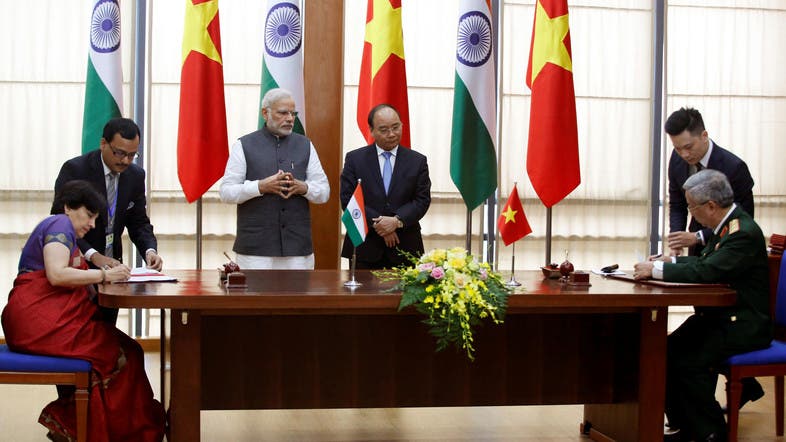
India’s Prime Minister Narendra Modi and his Vietnamese counterpart Nguyen Xuan Phuc witness the two countries’ officials signing a military cooperation agreement at the Government office in Hanoi, September 3, 2016. (Reuters)
New evidence appears to show Beijing restarting large-scale land reclamation in the disputed South China Sea, despite an international court ruling rejecting most of China’s claims. It suggests China had ordered barges to Scarborough Shoal and begun construction, according to a statement by Philippine president Rodrigo Duterte last Friday. In the face of Beijing’s continued actions to assert its territorial claims, other nations are partnering up to increase their military ties and defense cooperation, including Vietnam and India.
Last Saturday’s visit to Vietnam by Indian Prime Minister Narendra Modi, the first by any Indian prime minister in 15 years, resulted in Modi offering his Vietnamese counterpart Nguyen Xuan Phuc a credit line of $500 million for defense cooperation.
The two countries are already cooperating on numerous defensive fronts, with New Delhi having earlier supplied Hanoi with another credit line of $100 million to purchase offshore patrol boats. Through the purchase of the patrol boats, Vietnam hopes to stop attacks on its fishermen—some 200 Vietnamese fishermen were attacked by Chinese boats in 2015, according to local Vietnamese government officials. India is also training Vietnamese military personnel in the operation of the Russian Kilo-class submarine. New Delhi also spent $23 million this year to set up a satellite monitoring station in Ho Chi Minh City, which will be activated soon and linked to an existing station in Indonesia.
More significantly, Hanoi has requested to purchase the supersonic Indo-Russian BrahMos missile from India, reputed to be the world’s fastest cruise missile at speeds up to three times the speed of sound. The unit cost of the BrahMos missile is $3 million, with a range of 290 kilometers (180 miles), and can be fired from land, sea and submarine. Negotiations on the purchase are expected to conclude by the end of the year. New Delhi is also considering a proposal to offer Hanoi a battleship armed with configurations of eight or 16 BrahMos missiles each. Vietnam sits at the top of the list of countries for Indian export of the missiles, followed by the Philippines. The other 9 nations expected to purchase the missiles from India include Malaysia, Thailand and United Arab Emirates.
So why is India, which sits far from the South China Sea, involving itself in this particular maritime dispute? New Delhi has no territorial claims in the area, and defense cooperation by New Delhi with those nations who are party to territorial disputes can only anger Beijing. Jeff M. Smith, Director of Asian Security Programs at the American Foreign Policy Council in Washington, argues, “Policymakers in Delhi were long constrained by the belief that advanced defense cooperation with Washington or Hanoi could provoke aggressive and undesirable responses from Beijing.”
Perhaps India’s greater involvement comes as New Delhi is growing more concerned that Beijing’s increased assertiveness in the South China Sea may extend to territory close to India. India shares a border with China, to which India deployed 100 tanks in July following an “increase in force levels” from China. China has also been busy building key infrastructure such as power stations, highways and seaports for the small island nations surrounding India. While Beijing rails against a perceived “containment” by the U.S., New Delhi may be feeling the same, as Beijing funds arch-rival Pakistan’s military and docks its submarines in Sri Lanka.
This latest offering of military assistance by New Delhi to Hanoi is a continuation of Modi’s foreign policy of reaching out to neighbors, in an effort to contain Beijing’s aspirations to geopolitical control and military presence in the region. Last March, Modi announced the provision of military and civilian assistance to the island nations of Maldives, Mauritius, the Seychelles and Sri Lanka, including the supply of patrol vessels, surveillance radars and ocean mapping services.
Most likely, Modi no longer considers New Delhi’s restraint as effective, having seen Beijing’s threats to freedom of navigation and overflight in the South China Sea, and the illegal construction of an artificial islands. When dealing in future with Beijing, Modi’s latest overtures toward Hanoi make it clear New Delhi has finally traded its carrot of non-interference for a stick of dynamite.